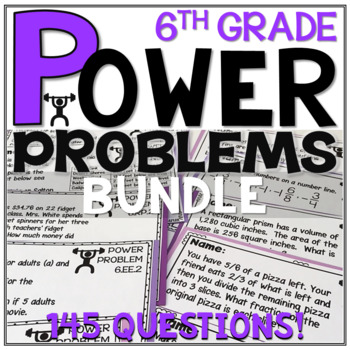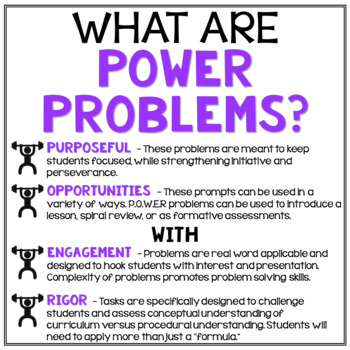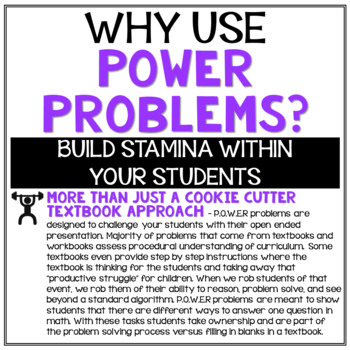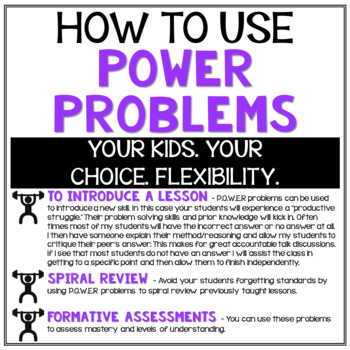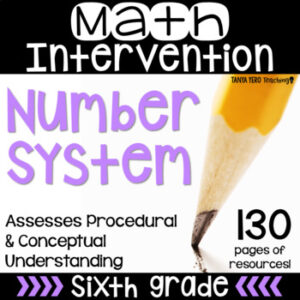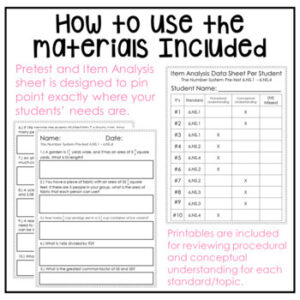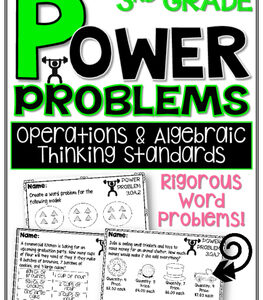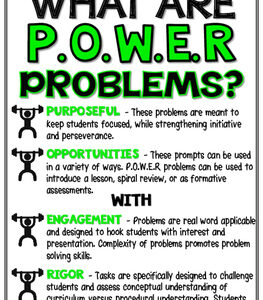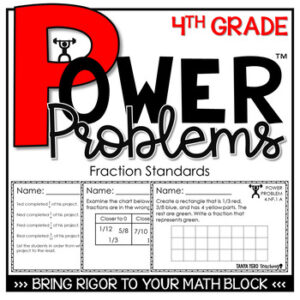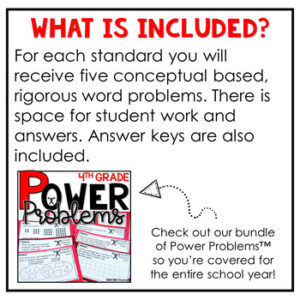Description
✐145 MATH COMMON CORE ALIGNED QUESTIONS TO TRANSFORM YOUR CLASSROOM!✐
WHAT ARE P.O.W.E.R PROBLEMS?
☛PURPOSEFUL – These problems are meant to keep students focused, while strengthening initiative and perseverance.
☛OPPORTUNITIES – These prompts can be used in a variety of ways. P.O.W.E.R problems can be used to introduce a lesson, spiral review, or as formative assessments.
WITH
☛ENGAGEMENT – Problems are real world applicable and designed to hook students with interest and presentation. Complexity of problems promotes problem solving skills.
☛RIGOR – Tasks are specifically designed to challenge students and assess conceptual understanding of curriculum versus procedural understanding. Students will need to apply more than just a “formula.”
WHY USE P.O.W.E.R PROBLEMS?
☛BUILD STAMINA WITHIN YOUR STUDENTS!
P.O.W.E.R problems are designed to challenge your students with their open ended presentation. Majority of problems that come from textbooks and workbooks assess procedural understanding of curriculum. Some textbooks even provide step by step instructions where the textbook is thinking for the students and taking away that “productive struggle” for children. When we rob students of that event, we rob them of their ability to reason, problem solve, and see beyond a standard algorithm. P.O.W.E.R problems are meant to show students that there are different ways to answer one question in math. With these tasks students take ownership and are part of the problem solving process versus filling in blanks in a textbook.
HOW TO USE POWER PROBLEMS:
YOUR KIDS. YOUR CHOICE. FLEXIBILITY.
☛TO INTRODUCE A LESSON – P.O.W.E.R problems can be used to introduce a new skill. In this case your students will experience a “productive struggle.” Their problem solving skills and prior knowledge will kick in. Often times most of my students will have the incorrect answer or no answer at all. I then have someone explain their method/reasoning and allow my students to critique their peer’s answer. This makes for great accountable talk discussions. If I see that most students do not have an answer I will assist the class in getting to a specific point and then allow them to finish independently.
☛SPIRAL REVIEW – Avoid your students forgetting standards, by using P.O.W.E.R problems to spiral review previously taught lessons.
☛FORMATIVE ASSESSMENTS – You can use these problems to assess mastery and levels of understanding.
**Five questions per standard/topic.**
Standards & Topics Covered
Ratios and Proportional Relationships
➥ 6.RP.1 – Understanding ratios
➥ 6.RP.2 –Understanding unit rates associated with a ratio
➥ 6.RP.3 – Use ratio and rate reasoning to solve real world problems
The Number System
➥ 6.NS.1 – Interpreting and commuting quotients of fractions
➥ 6.NS.2 – Fluently divide multi-digits numbers
➥ 6.NS.3 – Fluently add, subtract, multiply, and divide
➥ 6.NS.4 – Finding the greatest common factor of two numbers
➥ 6.NS.5 – Understanding positive and negative numbers
➥ 6.NS.6 – Understanding a rational number as a point on a number line
➥ 6.NS.7 – Ordering absolute value of rational numbers
➥ 6.NS.8 – Solve real world problems by graphing points on a coordinate plane
Expressions and Equations
➥ 6.EE.1 – Write and evaluate numerical expressions involving exponents
➥ 6.EE.2 – Write, read, and evaluate expressions using variables
➥ 6.EE.3 – Apply the properties of operations to generate equivalent expressions.
➥ 6.EE.4 – Identify when two expressions are equivalent
➥ 6.EE.5 – Understand solving an equation or inequality as a process of answering a question:
➥ 6.EE.6 – Use variables to represent numbers and write expressions when solving a real-world or mathematical problem
➥ 6.EE.7 – Solve real-world and mathematical problems by writing and solving equations
➥ 6.EE.8 – Writing inequalities
➥ 6.EE.9 – Using variables to represent two quantities in real world problems
Geometry
➥ 6.G.1 – Finding area of triangles
➥ 6.G.2 – Finding volume of prisms with fractional length amounts
➥ 6.G.3 – Drawing polygons on a coordinate plane
➥ 6.G.4 – Represent three-dimensional figures using nets made up of rectangles and triangles
Statistics and Probability
➥ 6.SP.1 – Recognize statistical questions
➥ 6.SP.2 – Understand that a set of data collected to answer a statistical question has a distribution,
➥ 6.SP.3 – Measuring the center of data
➥ 6.SP.4 – Display numerical data in plots on a number line, including dot plots, histograms, and box plots.
➥ 6.SP.5 – Summarize numerical data sets


